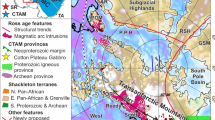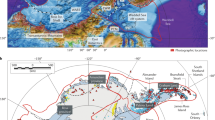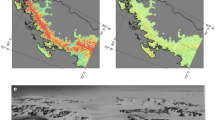Abstract
I HAVE already presented a morphological reconstruction of the continental fragments of Gondwanaland in the southwestern Pacific1. The reassembly was based on the computer-generated fits of Australia and Antarctica2,3 (which match the 1,000–fathom and 500–fathom isobaths). The method used in each case2,3 is a ‘least squares’ geometric fit of the selected isobath. Another fit has recently been proposed4, for this fit an instantaneous rotation pole is determined from fracture zones, at 10.8° N, 32.2° E, but the Australia–Antarctica fit is based on a ‘least squares’ geometric pole at 6° S, 40.5° E. I suggest that all of these fits may be in error by about 250 km, as present-day isobaths only define poorly the predrift continental edges.
This is a preview of subscription content, access via your institution
Access options
Subscribe to this journal
Receive 51 print issues and online access
$199.00 per year
only $3.90 per issue
Buy this article
- Purchase on Springer Link
- Instant access to full article PDF
Prices may be subject to local taxes which are calculated during checkout
Similar content being viewed by others
References
Griffiths, J. R., Nature, 234, 203 (1971).
Sproll, W. P., and Dietz, R. S., Nature, 222, 345 (1969).
Smith, A. G., and Hallam, A., Nature, 225, 139 (1970).
McKenzie, D., and Sclater, J. G., Geophys. J. R. astr. Soc., 24, 437 (1971).
Weissel, J. K., and Hayes, D. E., Nature, 231, 518 (1971).
Weissel, J. K., and Hayes, D. E., Antarctic Oceanology II: the Australian–New Zealand Sector, Antarctic Research Series, 19, 165 (American Geophysical Union, Washington, 1972).
Hayes, D. E., and Ringis, J., Nature, 243, 454 (1973).
Kennett, J. P., et al., Geotimes, 18, 14 (1973).
Griffiths, J. R., thesis. Univ. Tasmania (1973).
Griffiths, J. R., J. Austr. Petrol. Explor. Ass., 11, 75 (1971).
Tectonic Map of Australia and New Guinea 1 :5 000 000 (Geological Society of Australia, 1971).
Geologic Map of Antarctica 1:5 000 000 (American Geographical Society, 1972).
Solomon, M., and Griffiths, J. R., Proceedings of the Tasman Geosyncline Symposium, Brisbane (in the press).
Talent, J. E., and Thomas, D. E., Regional Guide to Victorian Geology, Second Edition (edit. by McAndrew, J., and Marsden, M. A. H.), 65 (University of Melbourne, Melbourne, 1973).
Sturm, A., and Carryer, S. J., N.Z. Jl Geol. Geophys., 13, 408 (1970).
Laird, M. G., Andrews, P. B., Kyle, P., and Jennings, P., Nature, 238, 34 (1972).
Crawford, A. R., and Campbell, K. S. W., Nature, 241, 11 (1973).
Daily, B., Jago, J. B., and Milnes, A. R., Nature, 244, 61 (1973).
Crawford, A. R., and Campbell, K. S. W., Nature, 244, 64 (1973).
Harrington, H. J., Burns, K. L., and Thompson, B. R., Nature, 245, 109 (1973).
Author information
Authors and Affiliations
Rights and permissions
About this article
Cite this article
GRIFFITHS, J. Revised continental fit of Australia and Antarctica. Nature 249, 336–338 (1974). https://doi.org/10.1038/249336a0
Received:
Revised:
Issue Date:
DOI: https://doi.org/10.1038/249336a0
This article is cited by
-
Bowers graben and associated tectonic features cross northern Victoria Land, Antarctica
Nature (1983)
-
Australian–Antarctic depression from the mid-ocean ridge to adjacent continents
Nature (1982)
-
Apparent polar wander paths carboniferous through cenozoic and the assembly of Gondwana
Geophysical Surveys (1982)
Comments
By submitting a comment you agree to abide by our Terms and Community Guidelines. If you find something abusive or that does not comply with our terms or guidelines please flag it as inappropriate.



